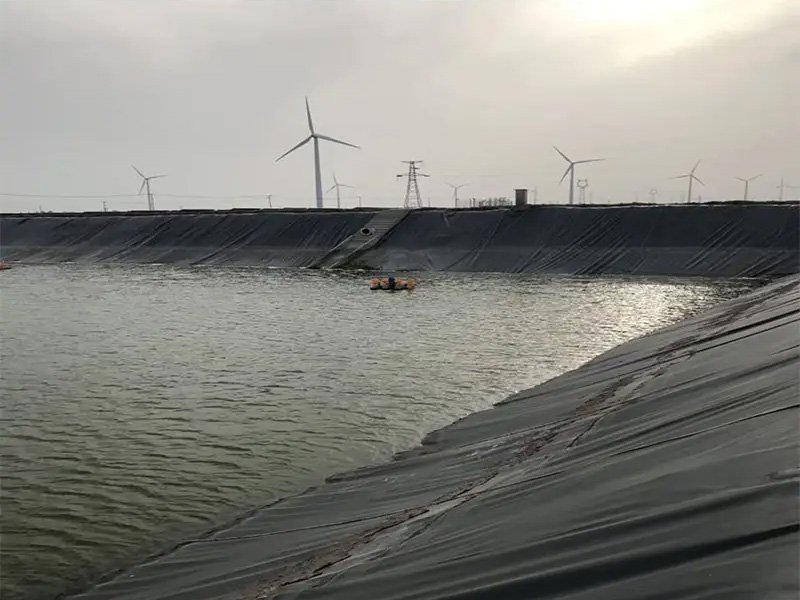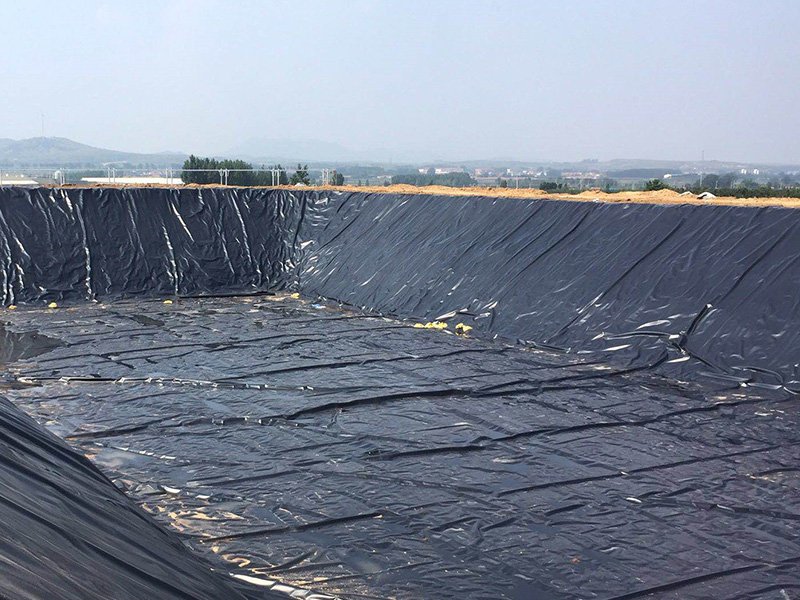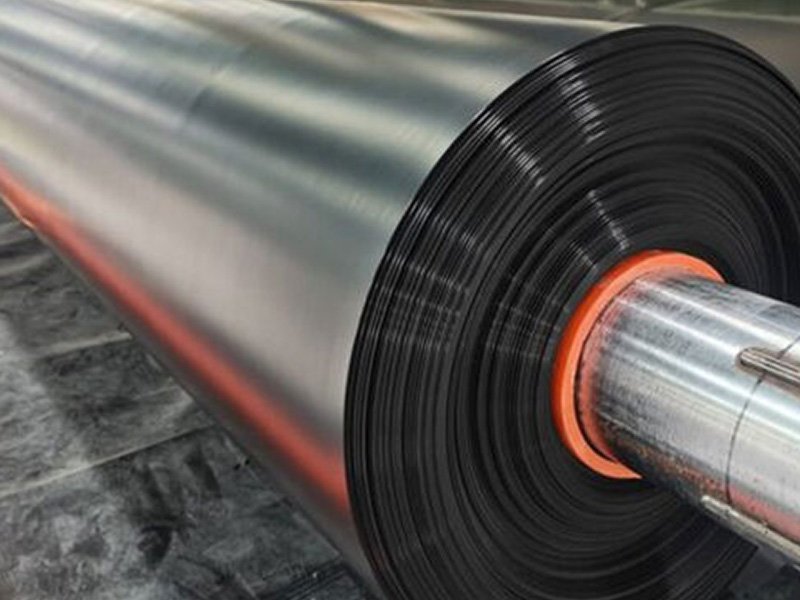LLDPE liner is the geomembrane liner designed and engineered with greater flexibility, excellent elongation and superior tensile properties for waste containment uses that require greater flexibility and elongation performance. GEOSINCERE LLDPE liners are available in thicknesses ranging from 20 to 120 mils and offer both textured and smooth options.
1. What Is LLPDE Liner?
LLDPE (Linear Low-Density Polyethylene) liner is a type of geomembrane liner fabricated from low-density polyethylene (LLDPE) material. These impermeable liners are utilized in diverse civil engineering and environmental applications to manage fluid migration and prevent contamination. Renowned for its pliability, robustness, and resistance to chemicals and UV radiation, LLDPE is a thermoplastic polymer.
The production of LLDPE geomembranes involves extruding LLDPE resin into large sheets or rolls of varying thicknesses, which are subsequently fused together to create a continuous impermeable barrier. To ensure a sturdy and watertight bond, seams are formed using techniques like thermal fusion, hot-air welding, or extrusion welding.
LLDPE liners find widespread use in landfill liners, mining and tailings pond liners, agricultural and irrigation ponds, secondary containment systems, wastewater treatment facilities, and water storage reservoirs. They serve as an efficient barrier against liquid, gas, and contaminant migration, safeguarding the environment and upholding structural integrity.
LLDPE liner is engineered with required thickness, chemical resistance, puncture resistance, and installation conditions. Incorporating various additives into the LLDPE formulation can enhance specific properties, such as UV stabilizers for prolonged durability in outdoor settings.
In civil engineering and environmental projects, LLDPE liners are extensively employed to deliver dependable and enduring containment solutions.


2. What Are Benefits Of LLDPE Liner?
LLDPE liner is a referred choice in civil engineering and environmental projects where fluid containment, durability, and resistance to environmental factors are crucial.
2.1 Superior flexibility
LLDPE geomembranes are highly flexible, allowing them to conform to subsidence and differential settlement. This flexibility is especially beneficial in applications where the subgrade is uneven or prone to movement.
2.2 UV and chemical resistant
LLDPE liners have excellent resistance to ultraviolet (UV) radiation and various chemicals. This makes them suitable for outdoor applications where exposure to sunlight and harsh chemicals is a concern.
2.3 Puncture resistant
LLDPE liners possess high puncture elongation properties, making them resistant to punctures. This is particularly advantageous in applications where there are potential risks of sharp objects or subgrade irregularities.
2.4 Long performance and durability
LLDPE geomembranes are known for their long service life and durability. They can withstand environmental stressors, such as temperature variations, without significant degradation, ensuring reliable performance over an extended period.
2.5 Chemical resistance
LLDPE liners exhibit resistance to a wide range of chemicals, including acids, alkalis, and organic solvents. This chemical resistance makes them suitable for applications involving containment of hazardous substances or liquids with corrosive properties.
2.6 Ease of installation
LLDPE liners are relatively easy to install due to their flexibility and weldability. They can be installed as large sheets or rolls, and the seams can be welded together using various techniques to create a continuous impermeable barrier.
3. What Is LLDPE Liner Used For?
LLDPE liners are suitable for a wide range of civil engineering and environmental projects that require containment and barrier systems. Here are some of the applicable projects where LLDPE geomembranes are commonly used:
3.1 Landfills
LLDPE geomembranes are extensively used as liners and caps in landfill projects. They prevent the migration of leachate (liquid waste) into the surrounding soil and groundwater, reducing the risk of contamination.
3.2 Mining and tailings ponds
LLDPE liner is used as liners in mining operations and tailings ponds. They create a barrier to prevent the seepage of potentially harmful chemicals and pollutants into the environment.
3.3 Water and wastewater treatment facilities
LLDPE geomembranes are employed in the construction of water and wastewater treatment facilities. They help to line tanks, basins, and lagoons, ensuring containment and preventing the loss of treated water or the intrusion of contaminants.
3.4 Agricultural and irrigation ponds
LLDPE liner is used to line agricultural and irrigation ponds, preventing water loss through seepage and maintaining proper water levels for crop irrigation.
3.5 Secondary containment systems
LLDPE geomembranes are utilized in secondary containment systems to prevent the leakage of hazardous substances from storage tanks, chemical processing areas, and industrial facilities. They provide an extra layer of protection against potential environmental contamination.
3.6 Water storage reservoirs
LLDPE geomembranes are employed in the construction of water storage reservoirs, ensuring water retention and preventing seepage into the surrounding soil.
3.7 Pond and canal liners
LLDPE liners are used to line ponds, canals, and other water management structures, preventing seepage and maintaining water levels.
4. What Is Difference of LLDPEand HDPE Liner?
LLDPE (low-density polyethylene) liner and HDPE (high-density polyethylene) liner are two different types of geomembranes with distinct characteristics. Here are the key differences between LLDPE and HDPE liner:
4.1 Different Density
The primary difference lies in the density of the polyethylene material. LLDPE has a lower density compared to HDPE. LLDPE typically has a density ranging from 0.910 to 0.940 g/cm³, while HDPE has a higher density of 0.940 to 0.970 g/cm³. The difference in density affects their mechanical properties.
4.2 Different Flexibility
LLDPE liners are more flexible and have higher elongation properties compared to HDPE geomembranes. This flexibility allows LLDPE to conform better to irregular surfaces and withstand movements and deformations.
4.3 Different Chemical Resistance
Both LLDPE and HDPE are known for their excellent chemical resistance. However, HDPE geomembranes generally exhibit superior chemical resistance compared to LLDPE geomembranes. HDPE is more resistant to a wide range of chemicals, including acids, alkalis, and hydrocarbons.
4.4 Different Strength and Stiffness
HDPE geomembranes are stronger and stiffer than LLDPE geomembranes. HDPE provides better tensile strength, tear resistance, and puncture resistance, making it suitable for projects that require higher mechanical properties.
4.5 Different UV Resistance
HDPE geomembranes typically have better UV resistance than LLDPE geomembranes. HDPE can withstand prolonged exposure to sunlight and environmental conditions without significant degradation. LLDPE geomembranes may require the addition of UV stabilizers to enhance their resistance to UV radiation.
4.6 Weldability
Both LLDPE and HDPE geomembranes are weldable using various techniques like thermal fusion, hot-air welding, or extrusion welding. However, the welding parameters and techniques may vary depending on the specific material and its properties.
The choice between LLDPE and HDPE geomembranes depends on the specific project requirements, site conditions, and the desired balance between flexibility, strength, and chemical resistance. HDPE geomembranes are often preferred in applications that require higher mechanical strength and chemical resistance, while LLDPE geomembranes are suitable for projects that prioritize flexibility and conformability.


5. How To Install LLDPE Liner?
In the installation of LLDPE geomembrane, the following steps are typically involved:
5.1 Site Preparation
The reservoir area needs to be properly prepared before installing the LLDPE geomembrane. This includes clearing the site of any debris, vegetation, or sharp objects that could potentially puncture or damage the geomembrane. The subgrade should be leveled and compacted to provide a stable foundation.
5.2 LLDPE Panels/Sheets
LLDPE geomembranes are typically supplied in large rolls or panels. These panels need to be carefully unrolled or unfolded to cover the designated area of the reservoir. Special care should be taken to avoid folds, creases, or wrinkles that could compromise the integrity of the liner.
5.3 Anchoring and Seaming
The geomembrane panels are anchored to the ground using methods such as soil cover, ballast, or anchor trenches. This helps secure the geomembrane in place and prevents uplift or movement due to water pressure. The panels are then seamed together using welding techniques appropriate for LLDPE, such as thermal fusion, hot-air welding, or extrusion welding. The seams should be strong and watertight to ensure the integrity of the liner system.
5.4 Pipe and Penetration Sealing
Special attention should be given to sealing around pipes, fittings, and other penetrations that pass through the LLDPE geomembrane. This is typically done using compatible sealing materials or techniques to prevent water leakage at these points.
5.5 Quality Control and Testing
Throughout the installation process, quality control measures should be implemented to ensure the proper installation of the LLDPE geomembrane. This may include visual inspections, leak testing, and verifying seam integrity. Any defects or issues should be addressed and rectified promptly.
5.6 Backfilling and Protection
Once the LLDPE geomembrane is installed and secured, suitable backfill material is placed on top of the liner to protect it from UV exposure, mechanical damage, and erosion. The backfill material should be carefully selected to avoid sharp objects or materials that may cause damage to the geomembrane.
As the leading geosynthetics manufacturer and supplier, GEOSINCERE offers complete line of HDPE and LLDPE geomembrane for worldwide customers.
Any questions or inquiries, please contact us.





